A Study on Spatial Accessibility of the Urban Stadium Emergency Response under the Flood Disaster Scenario
Abstract
1. Introduction
2. Data and Methodology
2.1. Study Area
2.2. Research Data
2.3. Methodology
2.3.1. Flood Numerical Simulation
2.3.2. Identification of Flooded Stadiums
2.3.3. Identification of Inundated Roads and Emergency Service Areas
2.3.4. Emergency Shortest Path
3. Result Analysis
3.1. Flood Inundation and Exposure Analysis
3.2. Emergency Service Area Analysis
3.3. Emergency Shortest Path
4. Discussion
5. Conclusions and Prospects
- (1)
- The research shows that under current and different recurrence scenarios, the inundation area is primarily concentrated within 3 km of the Huangpu River. Furthermore, it shows a trend of gradual expansion from north to south.
- (2)
- In extreme flood scenarios, more and more stadiums are affected as the flooded area extends. 8, 12 and 16 stadiums are flooded under the once-in-a-century flood scenario in 2010, 2030 and 2050 respectively; 17, 17 and 22 stadiums are flooded under the once-in-a-millennium flood scenario in 2010, 2030 and 2050 respectively.
- (3)
- Under normal and flooding inundation scenarios, medical facilities in central Shanghai have the fastest paths to reach each stadium according to the speeds of S1, S2 and S3. In the flood scenario, some roads along the Huangpu River in the municipal area are impassable to vehicles due to flooding. Some stadiums might have delays or even unavailability of medical emergency vehicles. Also, up to 15 stadiums will experience delays in accessing emergency services.
- (4)
- Overall, the floods do not affect the central city to a large extent, with the impact mainly concentrated on both sides of the Huangpu River. However, as most of the city’s significant sports events held in professional stadium facilities are located along the river, the situation will be even more complicated if the stadiums are damaged. Therefore, it is necessary to explore further disaster prevention and mitigation measures for stadiums in central urban areas in the case of flooding.
Author Contributions
Funding
Conflicts of Interest
References
- Field, C.B.; Barros, V.R.; Change, I.P.C. (Eds.) Climate Change 2014: Impacts, Adaptation, and Vulnerability. Part A: Global and Sectoral Aspects; Contribution of Working Group II to the Fifth Assessment Report of the Intergovernmental Panel on Climate Change; Guangdong Academy of Agricultural Sciences: Guangzhou, China, 2014. [Google Scholar]
- Qiu, H.J.; Cao, M.M.; Sheng, H.U.; Wang, Y.M.; Hao, J.Q.; Liu, W. Susceptibility and Periodicity of Flood Disasters Since the 1950s in China. Earth Environ. 2014, 42, 17–24. [Google Scholar]
- Yin, Z.E.; Xu, S.Y.; Yin, J.; Wang, J. Small-scale Based Scenario Modeling and Disaster Risk Assessment of Urban Rainstorm Water-logging. Acta Geogr. Sin. 2010, 65, 553–562. [Google Scholar]
- Mules, T.; Faulkner, B. An economic perspective on special events. Tour. Econ. 1996, 2, 107–117. [Google Scholar] [CrossRef]
- Crompton, J.L. The economic impact of sports tournaments and events. Parks Recreat.-West VA 1999, 34, 142–151. [Google Scholar]
- Burbank, M.; Andranovich, G.; Heying, C.H. Olympic Dreams: The Impact of Mega-Events on Local Politics; Lynne Rienner Publishers: Colorado, CO, USA, 2001. [Google Scholar]
- Baade, R.A.; Dye, R.F. The impact of stadium and professional sports on metropolitan area development. Growth Change 1990, 21, 1–14. [Google Scholar] [CrossRef]
- Stevens, T. Sport and Urban Tourism Destinations: The Evolving Sport, Tourism and Leisure Functions of the Modern Stadium. In Sport Tourism Destinations; Elsevier: Amsterdam, The Netherlands, 2005; pp. 205–220. [Google Scholar]
- Li, S.X. Multi Functions of Large-scale Venues in the Construction of Public Sports Service System. J. Chengdu Sport Univ. 2014, 40, 17–21. [Google Scholar]
- Wang, F.Q.; Li, Q.Y. The Correlation between Traffic Accessibility and Positioning of Ten Major Large-Medium-sized Gymnasiums: A Case Study on the Guang-Fo Area. South Archit. 2021, 6, 100–106. [Google Scholar]
- Ma, T.P. The Value of Sports Stadium in Emergency Management and Traditional Cultural and Sports Functions. J. Hunan Univ. 2021, 35, 84–92. [Google Scholar]
- Fang, C.N.; Liu, F.Z. Construction of Wuhan Makeshift Hospitals and Functional Expansion of Sports Stadiums under COVID-19 Crisis. J. Wuhan Inst. Phys. Educ. 2020, 54, 5–11. [Google Scholar]
- Solomon, S. IPCC (2007): Climate Change the Physical Science Basis; Agu Fall Meeting Abstracts; United States Government Publishing Office: Washington, DC, USA, 2007; p. U43D-01. [Google Scholar]
- Liao, Y.; Nie, C.; Yang, L.; Li, H. An overview of the risk assessment of flood disaster. Prog. Geogr. 2012, 31, 361–367. [Google Scholar]
- Yin, J.; Jing, Y.; Yu, D.; Ye, M.; Yang, Y.; Liao, B. A vulnerability assessment of urban emergency in schools of Shanghai. Sustainability 2019, 11, 349. [Google Scholar] [CrossRef]
- Shan, X.; Wen, J.; Zhang, M.; Wang, L.; Ke, Q.; Li, W.; Du, S.; Shi, Y.; Chen, K.; Liao, B. Scenario-based extreme flood risk of residential buildings and household properties in Shanghai. Sustainability 2019, 11, 3202. [Google Scholar] [CrossRef]
- Shi, Y. Population vulnerability assessment based on scenario simulation of rainstorm-induced waterlogging: A case study of Xuhui District, Shanghai City. Nat. Hazards 2013, 66, 1189–1203. [Google Scholar] [CrossRef]
- Yin, J.; Yu, D.; Lin, N.; Wilby, R.L. Evaluating the cascading impacts of sea level rise and coastal flooding on emergency response spatial accessibility in Lower Manhattan, New York City. J. Hydrol. 2017, 555, 648–658. [Google Scholar] [CrossRef]
- Yang, J.; Pei, Y.; Zhang, Y.; Ge, Q. Risk assessment of precipitation extremes in northern Xinjiang, China. Theor. Appl. Climatol. 2018, 132, 823–834. [Google Scholar] [CrossRef]
- Chen, Y.; Wang, Y.; Zhang, Y.; Luan, Q.; Chen, X. Flash floods, land-use change, and risk dynamics in mountainous tourist areas: A case study of the Yesanpo Scenic Area, Beijing, China. Int. J. Disaster Risk Reduct. 2020, 50, 101873. [Google Scholar] [CrossRef]
- Chen, Y.; Li, J.; Chen, A. Does high risk mean high loss: Evidence from flood disaster in southern China. Sci. Total Environ. 2021, 785, 147127. [Google Scholar] [CrossRef]
- Becker, P.; Tehler, H. Constructing a common holistic description of what is valuable and important to protect: A possible requisite for disaster risk management. Int. J. Disaster Risk Reduct. 2013, 6, 18–27. [Google Scholar] [CrossRef]
- Coles, D.; Yu, D.; Wilby, R.L.; Green, D.; Herring, Z. Beyond ‘flood hotspots’: Modelling emergency service accessibility during flooding in York, UK. J. Hydrol. 2017, 546, 419–436. [Google Scholar] [CrossRef]
- Mojtahedi, M.; Oo, B.L. Critical attributes for proactive engagement of stakeholders in disaster risk management. Int. J. Disaster Risk Reduct. 2017, 21, 35–43. [Google Scholar] [CrossRef]
- Yin, J.; Xu, S.; Jing, Y.; Yin, Z.; Liao, B. Evaluating the impact of fluvial flooding on emergency responses accessibility for a mega-city’s public services: A case study of emergency medical service. J. Geogr. Sci. 2018, 73, 1737–1747. [Google Scholar]
- Asgary, A.; Anjum, M.I.; Azimi, N. Disaster recovery and business continuity after the 2010 flood in Pakistan: Case of small businesses. Int. J. Disaster Risk Reduct. 2012, 2, 46–56. [Google Scholar] [CrossRef]
- Gourevitch, J.D.; Singh, N.K.; Minot, J.; Raub, K.B.; Rizzo, D.M.; Wemple, B.C.; Ricketts, T.H. Spatial targeting of floodplain restoration to equitably mitigate flood risk. Glob. Environ. Change 2020, 61, 102050. [Google Scholar] [CrossRef]
- Xiao, Y.; Tian, K.; Yuan, M.; Ouyang, Y.; Huang, H. Examining the complex relationships between socioeconomic development and the improvement of ecological environment in post-disaster reconstruction: The case of Wenchuan earthquake disaster area in Western China. J. Clean. Prod. 2022, 337, 130581. [Google Scholar] [CrossRef]
- Arrighi, C.; Pregnolato, M.; Dawson, R.; Castelli, F. Preparedness against mobility disruption by floods. Sci. Total Environ. 2019, 654, 1010–1022. [Google Scholar] [CrossRef]
- Duarte, M.; Fonseca, P.; Ortigao, A. Flash flood control works around the Maracana stadium district in Rio de Janeiro, Brazil. In Institution of Civil Engineers-Civil Engineering; Thomas Telford Ltd: London, UK, 2013; pp. 44–48. [Google Scholar]
- Zhu, Y. Strategies for Prevention and Control of Flood Control Safety and Environmental Risks in Stadiums under the Influence of Marine Climate. J. Coast. Res. 2020, 104, 756–760. [Google Scholar] [CrossRef]
- Environment, D.F.; Affairs, R. The National Flood Emergency Framework for England; Defra: London, UK, 2014. [Google Scholar]
- Shi, Y.; Yao, Q.; Wen, J.; Xi, J.; Li, H.; Wang, Q. A spatial accessibility assessment of urban tourist attractions emergency response in Shanghai. Int. J. Disaster Risk Reduct. 2022, 74, 102919. [Google Scholar] [CrossRef]
- Quan, R. Risk assessment of flood disaster in Shanghai based on spatial–temporal characteristics analysis from 251 to 2000. Environ. Earth Sci. 2014, 72, 4627–4638. [Google Scholar] [CrossRef]
- Yin, J.; Yu, D.; Yin, Z.; Wang, J.; Xu, S. Modelling the combined impacts of sea-level rise and land subsidence on storm tides induced flooding of the Huangpu River in Shanghai, China. Clim. Change 2013, 119, 919–932. [Google Scholar] [CrossRef]
- Yin, J.; Yu, D.; Yin, Z.; Wang, J.; Xu, S. Modelling the anthropogenic impacts on fluvial flood risks in a coastal mega-city: A scenario-based case study in Shanghai, China. Landsc. Urban. Plan. 2015, 136, 144–155. [Google Scholar] [CrossRef]
- He, F.F.; Hu, H.Z.; Dong, G.T.; Xu, H.Q. Compound Flooding Simulation and Prediction of Future Recurrence in Shanghai Downtown Area. J. Catastrophol. 2020, 35, 93–98. [Google Scholar]
- Notice of the General Office of the Shanghai Municipal People’s Government on the Issuance of the “14th Five-Year Plan” for the Development of Sports in Shanghai. 2021. Available online: https://www.shanghai.gov.cn/202120bgtwj/20211022/956b7bbb68fb4267bbcd6b5b440b5507.html (accessed on 14 September 2022).
- Yin, J.; Yu, D.; Yin, Z.; Wang, J.; Xu, S. Multiple scenario analyses of Huangpu River flooding using a 1D/2D coupled flood inundation model. Nat. Hazards 2013, 66, 577–589. [Google Scholar] [CrossRef]
- Wang, J.; Deng, Y.; Song, C.; Tian, D. Measuring time accessibility and its spatial characteristics in the urban areas of Beijing. J. Geogr. Sci. 2016, 26, 1754–1768. [Google Scholar] [CrossRef]
- Yin, J.; Yu, D.; Wilby, R. Modelling the impact of land subsidence on urban pluvial flooding: A case study of downtown Shanghai, China. Sci. Total Environ. 2016, 544, 744–753. [Google Scholar] [CrossRef]
- Li, M.; Kwan, M.-P.; Yin, J.; Yu, D.; Wang, J. The potential effect of a 100-year pluvial flood event on metro accessibility and ridership: A case study of central Shanghai, China. Appl. Geogr. 2018, 100, 21–29. [Google Scholar] [CrossRef]
- Su, F.; Yin, J.; Yin, Z.E.; Yu, D.P.; Xu, S.Y. Variation Analysis of Flood Dynamic Risk in Huangpu River Basin. Sci. Geogr. Sin. 2014, 34, 621–626. [Google Scholar]
- Stott, P. How climate change affects extreme weather events. Science 2016, 352, 1517–1518. [Google Scholar] [CrossRef]
- Huff, F.A. Characteristics and Contributing Causes of an Abnormal Frequency of Flood-Producing Rainstorms at Chicago 1. JAWRA J. Am. Water Resour. Assoc. 1995, 31, 703–714. [Google Scholar] [CrossRef]
- Xu, H.; Ma, C.; Lian, J.; Xu, K.; Chaima, E. Urban flooding risk assessment based on an integrated k-means cluster algorithm and improved entropy weight method in the region of Haikou, China. J. Hydrol. 2018, 563, 975–986. [Google Scholar] [CrossRef]
- Sohn, J. Evaluating the Significance of Highway Network Links Under the Flood Damage: An Accessibility Approach; Transportation Research Part A: Policy and Practice; Elsevier: Amsterdam, The Netherlands, 2006; pp. 491–506. [Google Scholar]
- Chang, M.-S.; Tseng, Y.-L.; Chen, J.-W. A Scenario Planning Approach for the Flood Emergency Logistics Preparation Problem Under Uncertainty; Transportation Research Part E: Logistics and Transportation Review; Elsevier: Amsterdam, The Netherlands, 2007; pp. 737–754. [Google Scholar]
- Bodoque, J.M.; Amérigo, M.; Díez-Herrero, A.; García, J.A.; Cortés, B.; Ballesteros-Cánovas, J.A.; Olcina, J. Improvement of resilience of urban areas by integrating social perception in flash-flood risk management. J. Hydrol. 2016, 541, 665–676. [Google Scholar] [CrossRef]
- Gulzar, S.M.; Mir, F.U.H.; Rafiqui, M.; Tantray, M.A. Damage assessment of residential constructions in post-flood scenarios: A case of 2014 Kashmir floods. Environ. Dev. Sustain. 2021, 23, 4201–4214. [Google Scholar] [CrossRef]
- Brown, M.T. Sport Facility Management: Organizing Events and Mitigating Risks. J. Sport Manag. 2004, 18, 296–298. [Google Scholar] [CrossRef]
- Dang, Z.; Liu, S.; Li, T.; Gao, L. Analysis of stadium operation risk warning model based on deep confidence neural network Algorithm. Comput. Intell. Neurosci. 2021, 2021, 3715116. [Google Scholar] [CrossRef]
- Leopkey, B.; Parent, M.M. Risk management strategies by stakeholders in Canadian major sporting events. Event Manag. 2009, 13, 153–170. [Google Scholar] [CrossRef]
- Gratz, J.; Church, R.; Noble, E. Safeguarding the Spectator. Weatherwise 2005, 58, 42–45. [Google Scholar] [CrossRef]
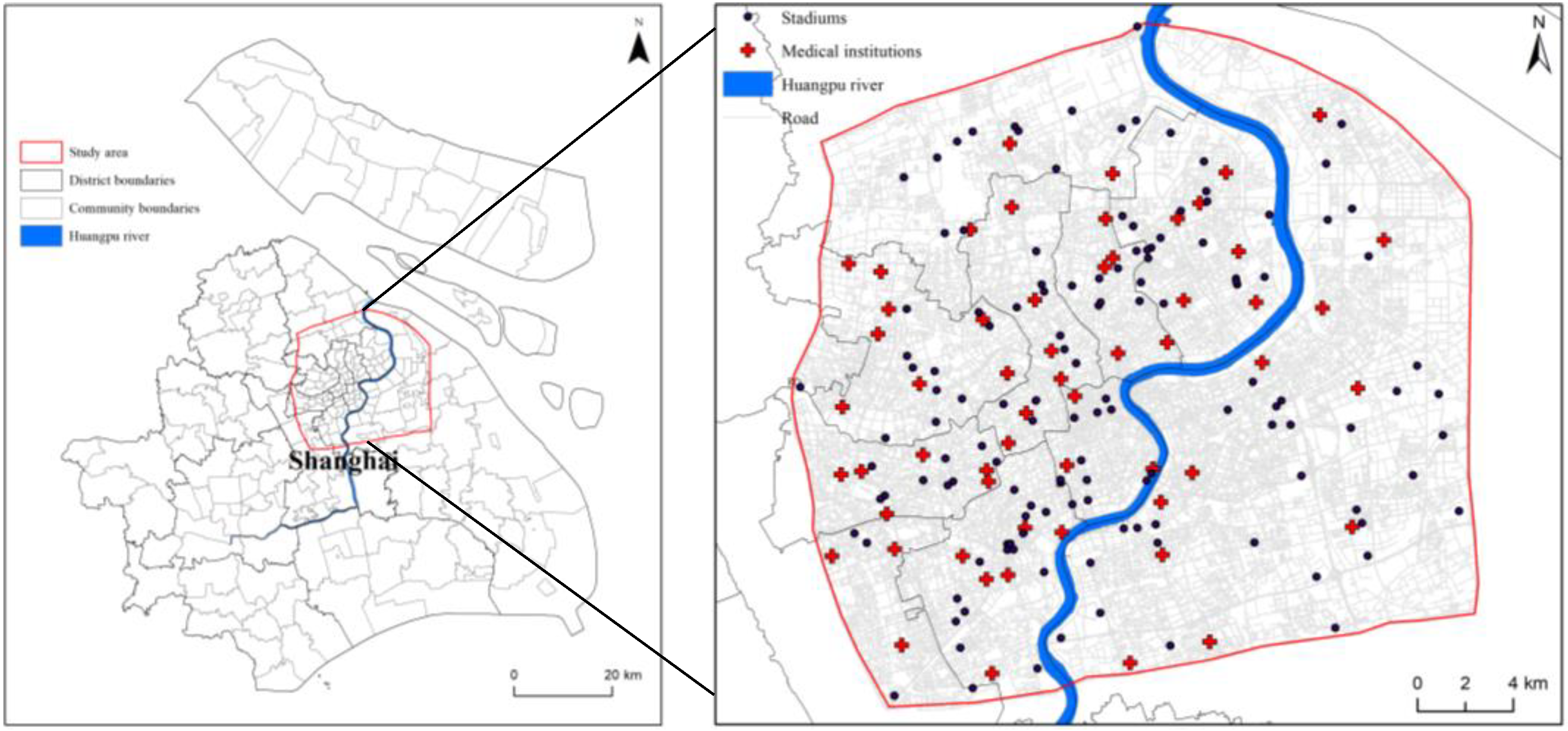
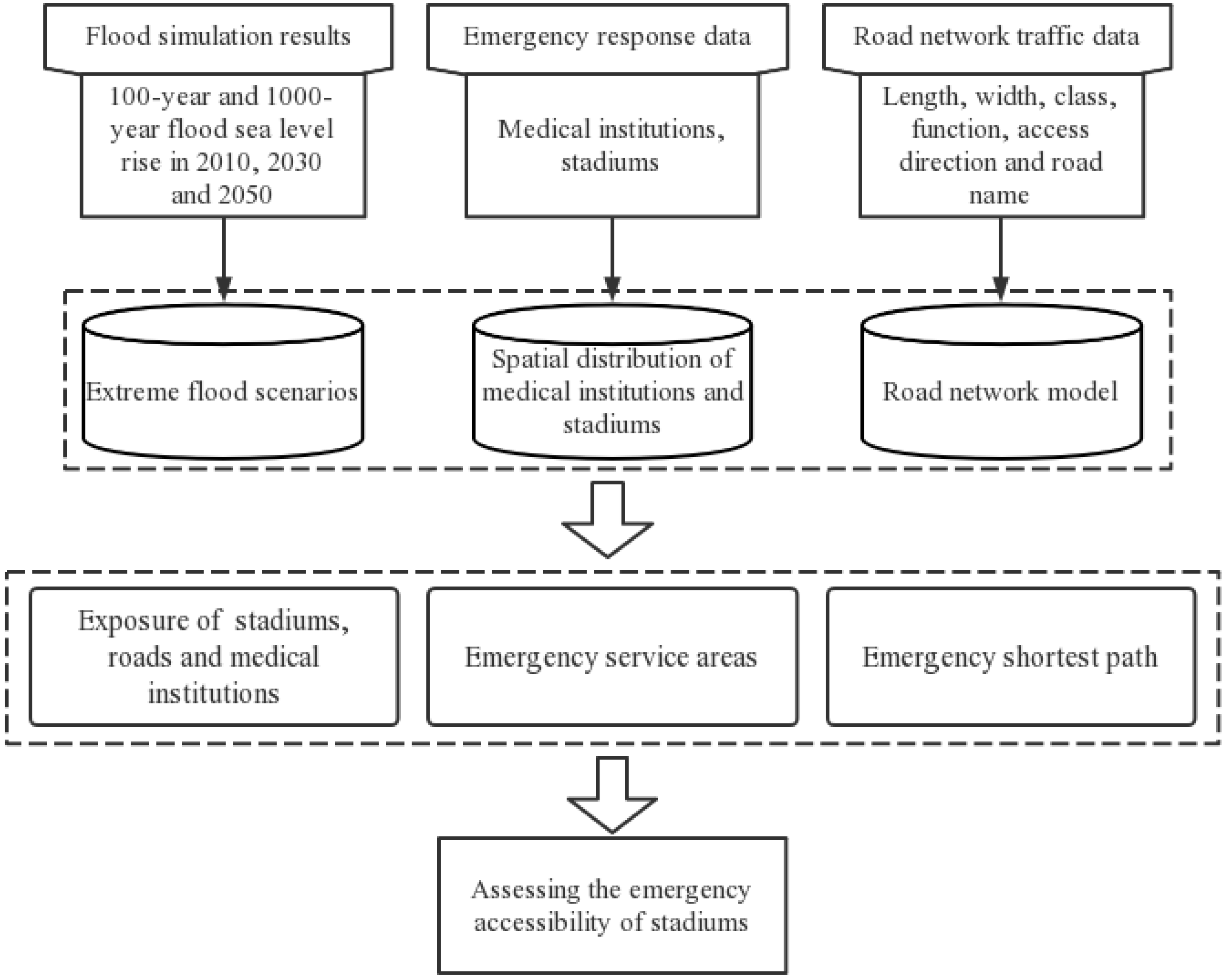
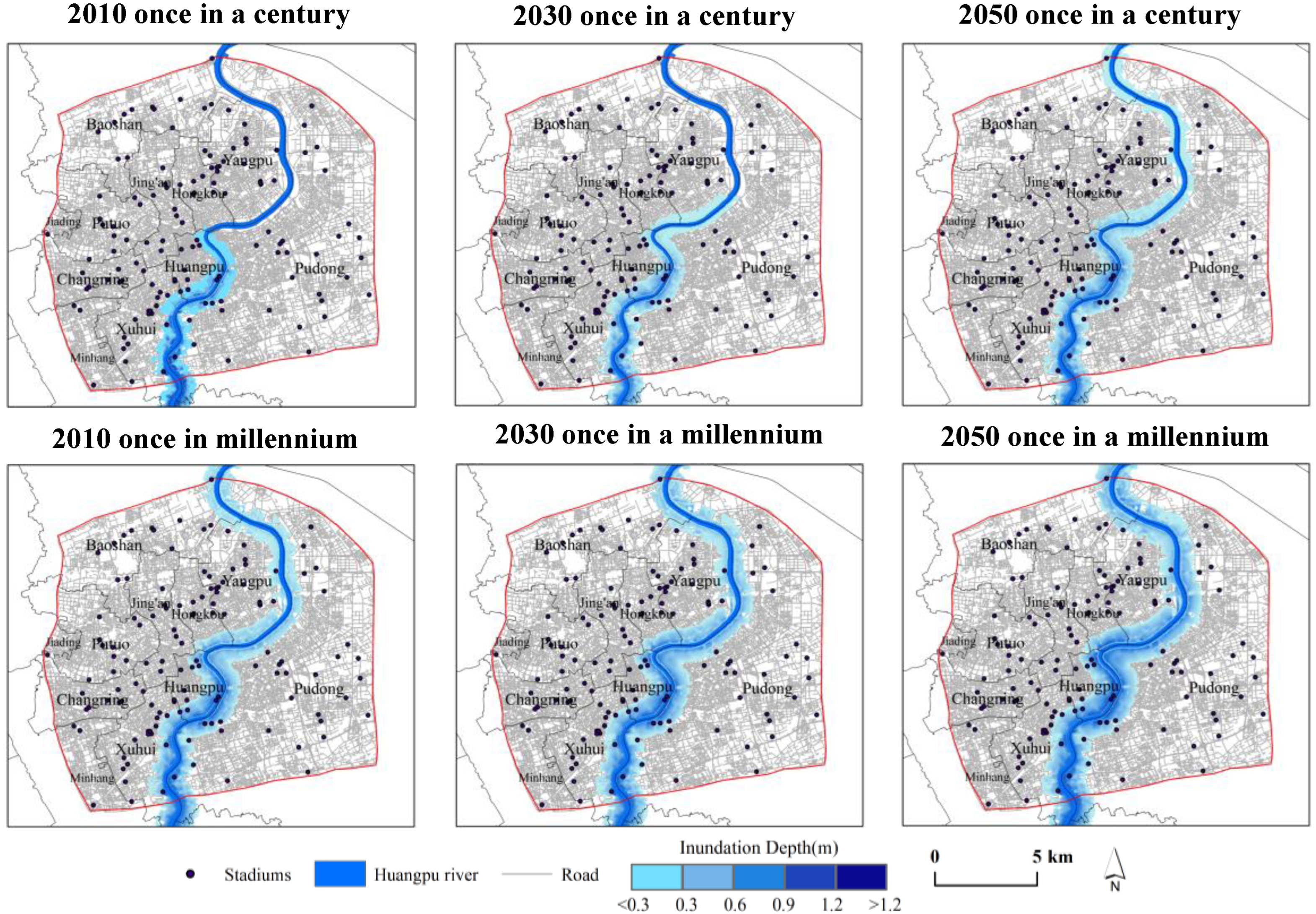
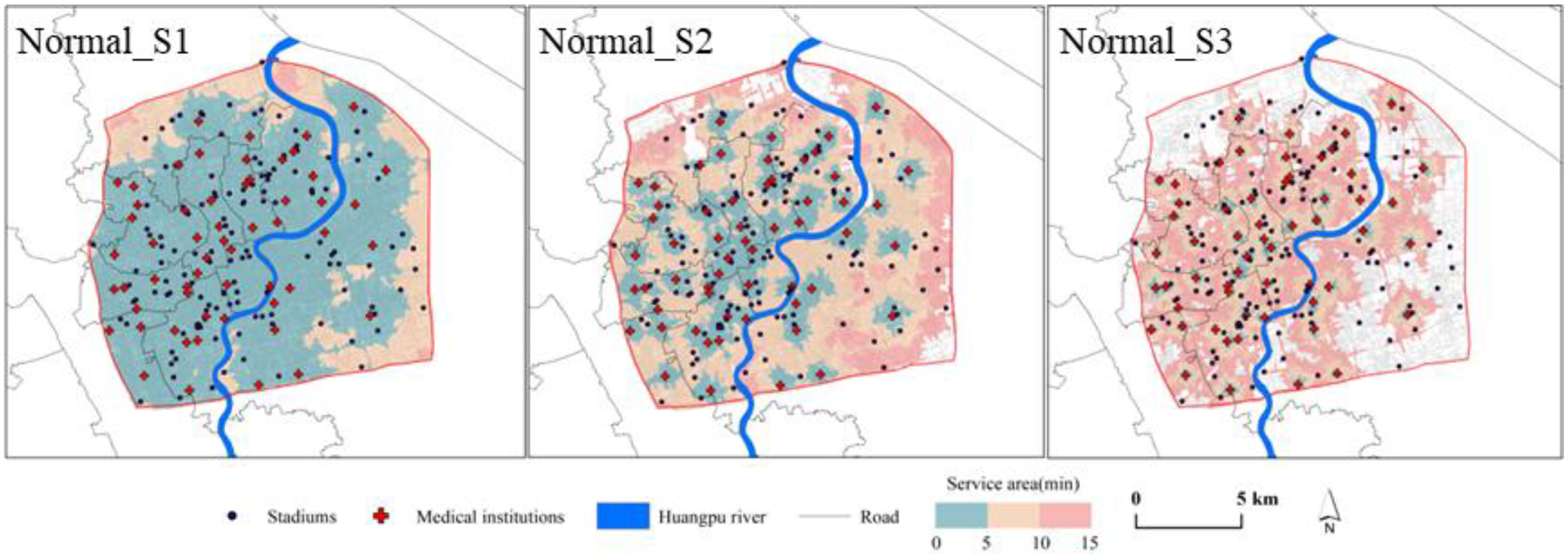
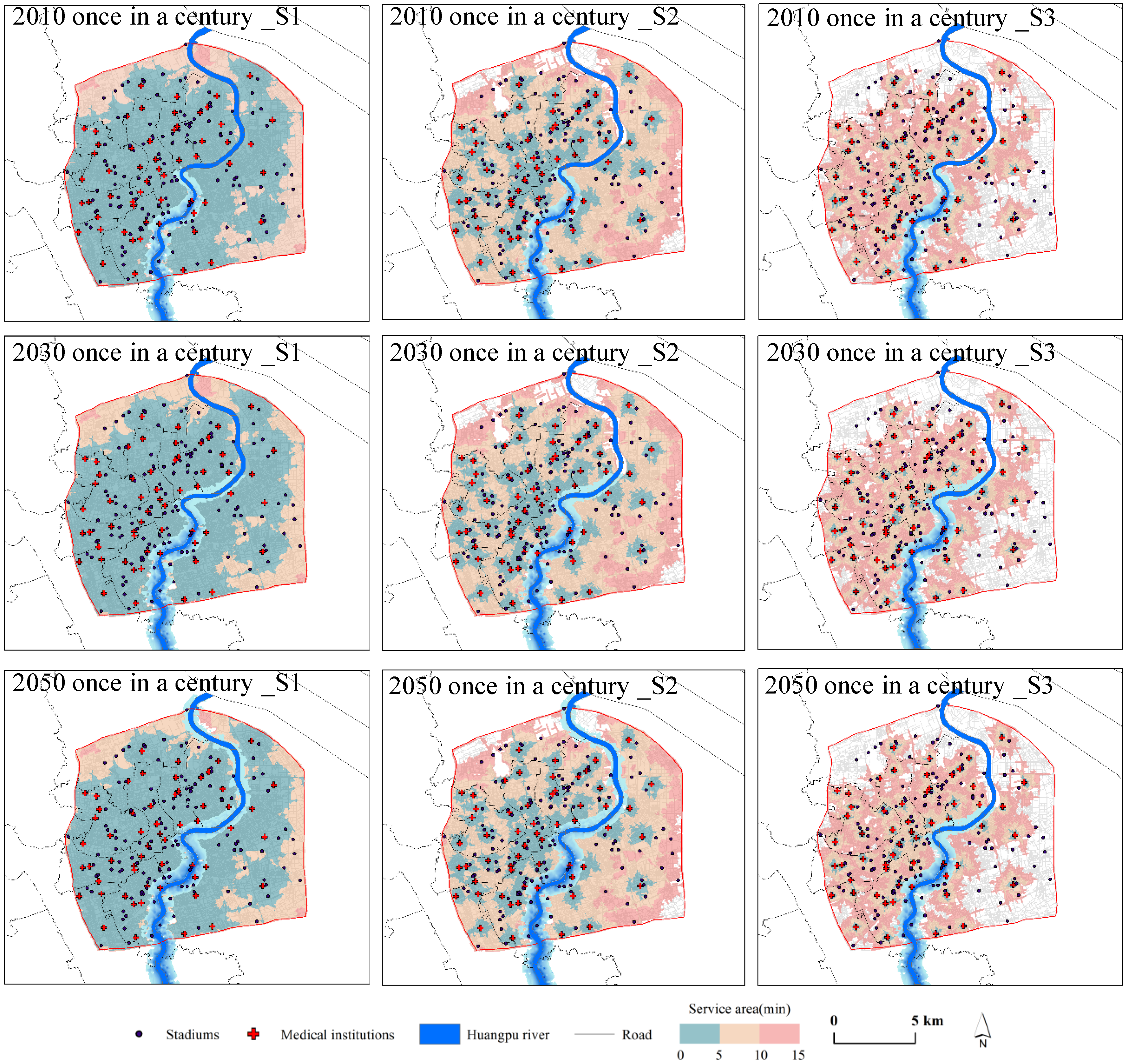

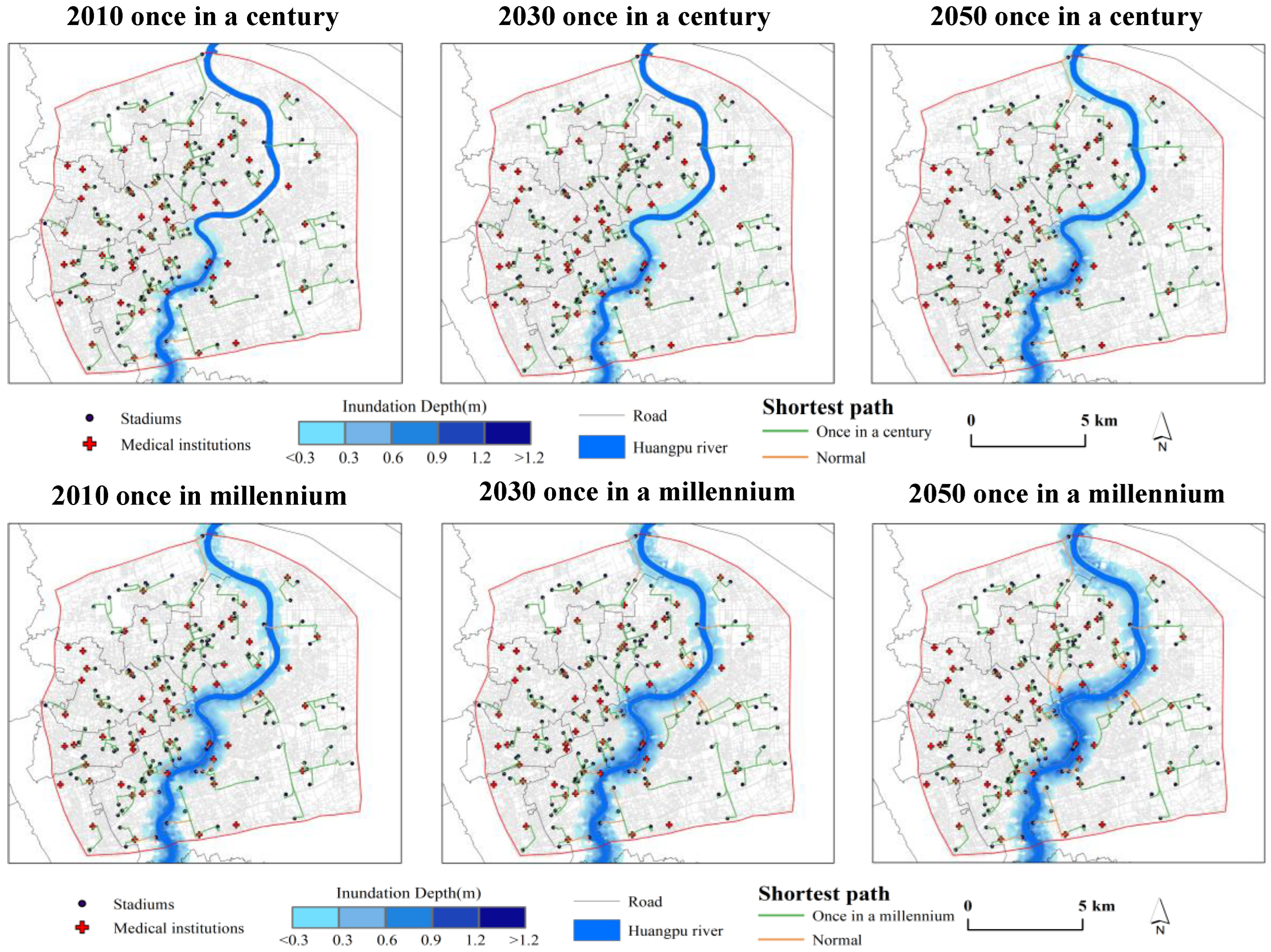
| Type | Elevated Road | Expressway | Main Road | Secondary Road | Branch Road |
|---|---|---|---|---|---|
| S1 (Maximum speed limit) | 120 | 80 | 60 | 50 | 30 |
| S2 (evening and weekend) | 1/2S1 | 1/2S1 | 1/2S1 | 1/2S1 | 1/2S1 |
| S3 (daytime) | 1/4S1 | 1/4S1 | 1/4S1 | 1/4S1 | 1/4S1 |
| Flood Scenarios | 5 min | 10 min | 15 min | ||||||
|---|---|---|---|---|---|---|---|---|---|
| S1 | S2 | S3 | S1 | S2 | S3 | S1 | S2 | S3 | |
| Normal | 123 | 61 | 11 | 137 | 123 | 61 | 137 | 137 | 107 |
| (90%) | (45%) | (8%) | (100%) | (90%) | (45%) | (100%) | (100%) | (78%) | |
| 2010_100y | 117 | 57 | 9 | 130 | 117 | 57 | 130 | 130 | 102 |
| (85%) | (42%) | (6%) | (95%) | (85%) | (42%) | (95%) | (95%) | (74%) | |
| 2030_100y | 116 | 55 | 9 | 129 | 116 | 57 | 129 | 129 | 101 |
| (85%) | (40%) | (6%) | (94%) | (85%) | (42%) | (94%) | (94%) | (74%) | |
| 2050_100y | 115 | 56 | 9 | 127 | 115 | 56 | 127 | 127 | 100 |
| (84%) | (41%) | (6%) | (93%) | (84%) | (41%) | (93%) | (93%) | (73%) | |
| 2010_1000y | 114 | 55 | 8 | 125 | 114 | 55 | 125 | 125 | 99 |
| (83%) | (40%) | (6%) | (91%) | (83%) | (40%) | (91%) | (91%) | (72%) | |
| 2030_1000y | 111 | 53 | 9 | 123 | 111 | 53 | 123 | 123 | 94 |
| (81%) | (39%) | (6%) | (90%) | (81%) | (39%) | (90%) | (90%) | (69%) | |
| 2050_1000y | 109 | 51 | 9 | 121 | 109 | 51 | 121 | 121 | 92 |
| (80%) | (37%) | (6%) | (88%) | (80%) | (37%) | (88%) | (88%) | (67%) | |
Publisher’s Note: MDPI stays neutral with regard to jurisdictional claims in published maps and institutional affiliations. |
© 2022 by the authors. Licensee MDPI, Basel, Switzerland. This article is an open access article distributed under the terms and conditions of the Creative Commons Attribution (CC BY) license (https://creativecommons.org/licenses/by/4.0/).
Share and Cite
Wang, Y.; Li, H.; Shi, Y.; Yao, Q. A Study on Spatial Accessibility of the Urban Stadium Emergency Response under the Flood Disaster Scenario. Sustainability 2022, 14, 17041. https://doi.org/10.3390/su142417041
Wang Y, Li H, Shi Y, Yao Q. A Study on Spatial Accessibility of the Urban Stadium Emergency Response under the Flood Disaster Scenario. Sustainability. 2022; 14(24):17041. https://doi.org/10.3390/su142417041
Chicago/Turabian StyleWang, Yiche, Hai Li, Yong Shi, and Qian Yao. 2022. "A Study on Spatial Accessibility of the Urban Stadium Emergency Response under the Flood Disaster Scenario" Sustainability 14, no. 24: 17041. https://doi.org/10.3390/su142417041
APA StyleWang, Y., Li, H., Shi, Y., & Yao, Q. (2022). A Study on Spatial Accessibility of the Urban Stadium Emergency Response under the Flood Disaster Scenario. Sustainability, 14(24), 17041. https://doi.org/10.3390/su142417041








